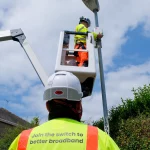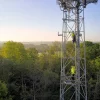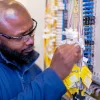UK Gov Hands Out £28m to Help Develop Future 6G Mobile Tech

The Department for Digital, Culture, Media and Sport (DCMS) has today handed out £28m to three universities (York, Bristol and Surrey) to help them team-up with major telecoms companies, including Nokia, Ericsson and Samsung, to both design and build future 6G based mobile broadband networks.
The 6G standard is currently still in the early R&D phase, thus we don’t expect to see the first commercial builds until around 2030. But it is widely expected to be aiming for theoretical peak data rates of up to 1Tbps (Terabits per second) – or 1000Gbps if you prefer – and may be able to harness radio spectrum up to the TeraHertz (THz) bands, while also using AI optimisations and other changes to improve network efficiency.
However, hitting such speeds in the real-world is a different ball game, due to various reasons, such as the highly variable mobile environment (weather, buildings and device choice etc. can all impact signal quality), the economic cost of needing to deploy a denser and more complex network (mobile operators end up preferring lower frequencies for better coverage) and other obstacles (building lots of new masts tends to upset some people).
Advertisement
Nevertheless, the development of future mobile technologies rarely waits for regulators and governments to decide their fate, which means that countries need to prepare well ahead of time. This is why today’s allocation of £28m – part of a wider £110m investment programme – to help fuel new 6G research centres is so important. In addition, it will also support the roll-out of 5G by making it easier for more firms to enter the market (e.g. supporting vendor neutral OpenRAN networks etc.).
The £110m programme also includes £80m for a new UK Telecoms Lab, which is to be built in Solihull (West Midlands). Under a new contract the government has signed with the National Physical Laboratory, the lab will act as a secure research facility for mobile network operators, suppliers and academics to research and test the security, resilience and performance of their 5G and, in the future, 6G network technology.
On top of that, a new R&D partnership with the Republic of Korea (South Korea) has also kicked off, which aims to accelerate the deployment of OpenRAN and associated technologies. The joint project, which will receive more than £3m (including £1.2 million from the UK Government), will focus on the power efficiency of emerging technical equipment – one of the obstacles slowing the deployment of such technologies.
At this point it’s worth remembering that the government and UK mobile operators hold a joint ambition for 35% of mobile network traffic to pass through OpenRAN kit by the end of the decade.
Advertisement
Michelle Donelan, Digital Secretary, said:
“The technology powering our phone and internet networks is evolving rapidly and with 6G on the horizon we must stay ahead of the curve.
This government investment will see top UK universities join forces with industry to develop the nuts and bolts underpinning new networks, create skilled jobs testing the security of the latest telecoms tech, and ensure our plan for a more diverse and innovative 5G market is sustained in the future.
The funding will also turbocharge our work to strengthen telecoms supply chains so we are no longer reliant on a handful of companies to develop and maintain our 5G networks.”
All of this is a necessary part of further developing both 5G and future 6G networks, although it’s worth keeping in mind that the 5G roll-out hasn’t gone as well as operators would have liked, due to many of the aforementioned issues and the Huawei ban. The big risk with 6G is that it might not do enough to overcome the challenges created by 5G and may instead simply move the technological goal posts further out, thus compounding existing challenges.
Not that this will stop the inevitable hype train that tends to precede the release of any new mobile generation, which in the case of 6G may sound awfully similar to the original promise of 5G. On the other hand, 6G is still a good few years away, so there’s plenty of time for network operators to catch-up and hopefully realise some of the other benefits that 5G can deliver. The government could aid this by setting a more ambitious coverage target.
Mark is a professional technology writer, IT consultant and computer engineer from Dorset (England), he also founded ISPreview in 1999 and enjoys analysing the latest telecoms and broadband developments. Find me on X (Twitter), Mastodon, Facebook, BlueSky, Threads.net and Linkedin.
« Openreach Sets 229 PetaBytes (PB) UK Data Traffic Record





















































I wonder what the 6G conspiracies will be like…
Same as 5G and 4G before that.
Always some scary death lazer.
At what point do we give up with wireless everything & go back to fixed wiring. I don’t like or see much point in putting everything conceivable device on some sort of wireless network.
I keep hearing of ‘smart cities’ which connect up traffic lights, street lighting, traffic sensors, security cameras, parking meters and all sorts to 5G. But so much could likely just use fixed wiring or 4G anyway.
Mind you, I live in a deprived northern town so the mobile networks around here are never congested with thousands of devices being connected (unlike I imagine what it would be like in Newcastle) – only time it has been was when the entire power supply in the town failed for a few hours
They can’t get 5G working reliably, so many better to sort that out first.
Works very reliably for me, so much so that i’ve demoted virgin media to being a backup link.
Every time it doesn’t work for one person they come screaming that it sucks or it’s a failure, or it doesn’t work at all for anyone. A lot of people will disagree with you.
Not really. Research isn’t operations. If we don’t begin research others will beat the UK to standardisation and British companies miss out on billions in revenue.
@Country Bumpkin, It is hit-and-miss around here by all accounts, but then this area is not well covered with 5G, I don’t have a 5G phone and in no rush to get one even if 5G worked fine here, because in my opinion 5G on a mobile phone is a complete total waste of time.
I know people in large cities that have 5G, and they tell they have to turn 5G off on their phone and use 4G a fair bit. 5G also don’t like buuildings.
More money wasted on tech along with the over hyped promise of 5G before it, most of us would of been happy with much higher network capacity and full 4G coverage in the UK than sub par battery hungry, pIgion delivery 5G services that most get.
Oddly but not always, switching off 5g on my phone I get better download speeds, that was a disappointment having swallowed the hype.
6G at frequencies approaching 100Ghz and above, would be direct line of sight and possibly only useful in high population or enclosed areas, like shopping centres, stadiums, trains, planes, etc and once you reach 300Ghz you’re in the far infrared optical spectrum. I suppose roadside cells and vehicle to vehicle connectivity might be possible, at high EHF and Infrared 6G frequencies, but the range would be limited by things like rainfall, fog, atmospherics and even the speed of the vehicles.
6G IOT applications will likely appear utilising existing 5G frequencies, but 6G should be considered as an add on to 5G, not a replacement.